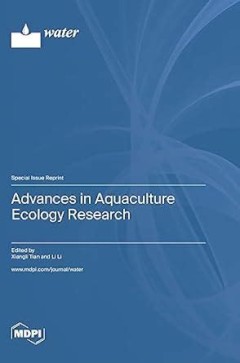Filter by

Advances in Artificial and Biological Membranes: Mechanisms of Ionic Sensitiv…
Ion-sensitive membrane-based sensors and ionic processes in bio-membranes are the focus of this book. The chapters are carefully chosen to characterize essential research trends, applications, and perspectives. They include solid contact ion-selective and reference electrodes and their electroanalytical behavior in zero and nonzero-current modes, planar and miniaturized multielectrode platforms…
- Edition
- -
- ISBN/ISSN
- 9783036510712
- Collation
- 153 hlm; ill., lamp.,
- Series Title
- -
- Call Number
- -

Advances in Aquatic Invertebrate Stem Cell Research
This publication is based upon work from COST Action '16203 MARISTEM Stem cells of marine/aquatic invertebrates: from basic research to innovative applications', supported by COST (European Cooperation in Science and Technology).COST (European Cooperation in Science and Technology) is a funding agency for research and innovation networks. Our Actions help connect research initiatives across Eur…
- Edition
- -
- ISBN/ISSN
- 9783036516356
- Collation
- 396 hlm; ill., lamp.,
- Series Title
- -
- Call Number
- -

Advances in Aquaculture Ecology Research
The discipline of aquaculture ecology is developing rapidly and has generated much valuable progress in recent decades. This reprint mainly describes the recent advances in the individual ecology of commercial aquatic organisms, the ecology of aquaculture systems, the interaction between aquaculture activities and the environment, the structure of function of microbial communities, the principl…
- Edition
- -
- ISBN/ISSN
- 9783036579757
- Collation
- 180 hlm; ill., lamp.,
- Series Title
- -
- Call Number
- -

Advances in Antifungal Development: Discovery of New Drugs and Drug Repurposing
This reprint describes recent advances made in the field of antifungal development, especially the discovery of new drugs and drug repurposing. The articles presented in this book provide useful information and insight for the development of new antifungal drugs or intervention strategies. The identification of new, safe molecules, and cellular targets, as well as the elucidation of their antif…
- Edition
- -
- ISBN/ISSN
- 9783036547671
- Collation
- 282 hlm; ill., lamp.,
- Series Title
- -
- Call Number
- -

Advances in Alternative Measures in Plant Protection
Due to increasing concern about the use of pesticides and its potential side effects, this book considers the development and application of alternative, environmental-friendly, plant protection methods for the control of weeds, disease, and pests (predators, parasitoids, competitors, plant-plant interactions, microelements, biopesticides). Some of the main advantages of the measures presented …
- Edition
- -
- ISBN/ISSN
- 9783036573977
- Collation
- 374 hlm; ill., lamp.,
- Series Title
- -
- Call Number
- -

ACTH Action in the Adrenal Cortex: From Molecular Biology to Pathophysiology
By stimulating adrenal gland and corticosteroid synthesis, the adrenocorticotropic hormone (ACTH) plays a central role in response to stress. In this Research Topic, a particular attention has been given to the recent developments on adrenocortical zonation; the growth-promoting activities of ACTH; the various steps involved in acute and chronic regulation of steroid secretion by ACTH, includin…
- Edition
- -
- ISBN/ISSN
- 9782889452323
- Collation
- oer.unej.ac.id
- Series Title
- -
- Call Number
- -

Advancements in Soil and Sustainable Agriculture
In the face of mounting challenges such as food insecurity and environmental degradation, the significance of sustainable agriculture has become increasingly apparent as a beacon for our collective future. Central to this transformative movement is the profound importance of soil health, which serves as the bedrock for both crop productivity and ecological resilience. The Special Issue "Advance…
- Edition
- -
- ISBN/ISSN
- 9783036597072
- Collation
- 196 hlm,: ill, lamp; 21 cm
- Series Title
- -
- Call Number
- -

Advancement in Dietary Assessment and Self-Monitoring Using Technology
Although methods to assess or self-monitor intake may be considered similar, the intended function of each is quite distinct. For the assessment of dietary intake, methods aim to measure food and nutrient intake and/or to derive dietary patterns for determining diet-disease relationships, population surveillance or the effectiveness of interventions. In comparison, dietary self-monitoring prima…
- Edition
- -
- ISBN/ISSN
- 9783039280599
- Collation
- 348 hlm; ill., lamp.,
- Series Title
- -
- Call Number
- -

Advanced Research on Sprouts and Microgreens as a Source of Bioactive Compounds
Today, researchers are focused on studying and identifying new products that can be beneficial for both food and pharmaceutical purposes. In this context, sprouts and microgreens are widely recognized as functional foods due to their high nutritional value, and in particular, their high bioactive compound content, which is mainly composed of phytochemicals. However, despite extensive research o…
- Edition
- -
- ISBN/ISSN
- 9783036571768
- Collation
- 224 hlm,: ill, lamp; 21 cm
- Series Title
- -
- Call Number
- -

Advanced Research on Glucosinolates in Food Products
Glucosinolate-containing foods, such as vegetables from the plant order Brassicales and its derivative products, are valued for their health-beneficial properties. The latter are linked to glucosinolate hydrolysis products, such as isothiocyanates.The book "Advanced Research on Glucosinolates in Food Products" collects the latest research on the impact of the whole food supply chain, including …
- Edition
- -
- ISBN/ISSN
- 9783036529769
- Collation
- 238 hlm,: ill, lamp; 21 cm
- Series Title
- -
- Call Number
- -
 Computer Science, Information & General Works
Computer Science, Information & General Works  Philosophy & Psychology
Philosophy & Psychology  Religion
Religion  Social Sciences
Social Sciences  Language
Language  Pure Science
Pure Science  Applied Sciences
Applied Sciences  Art & Recreation
Art & Recreation  Literature
Literature  History & Geography
History & Geography